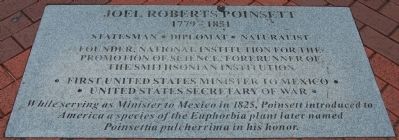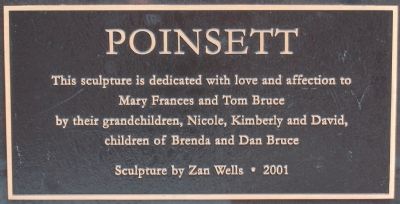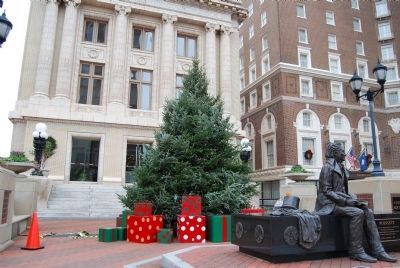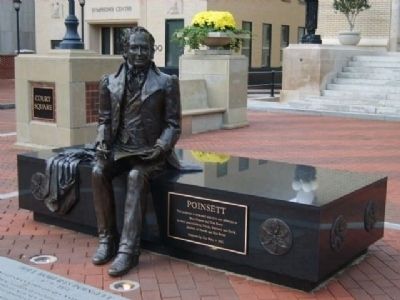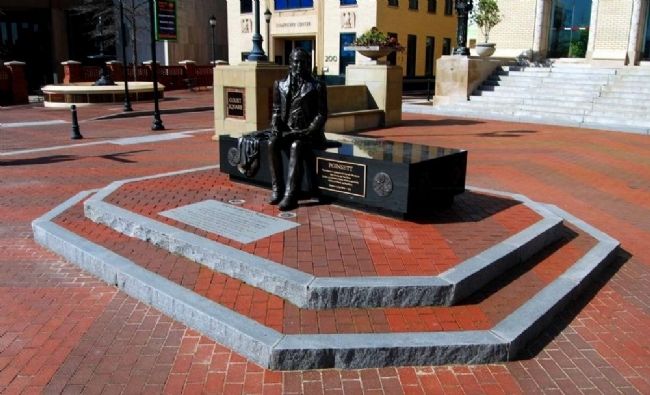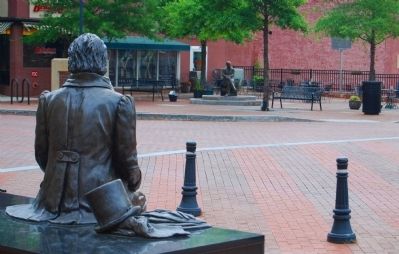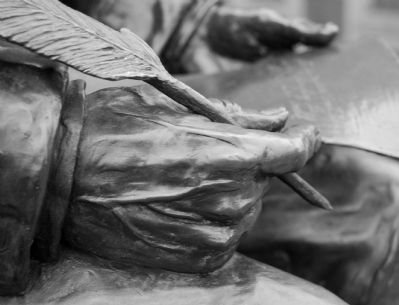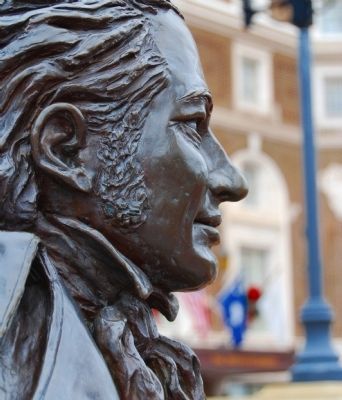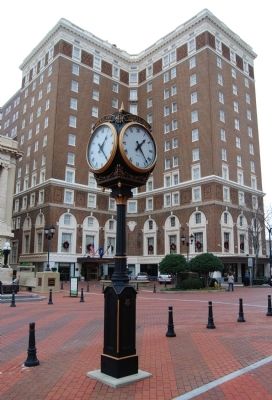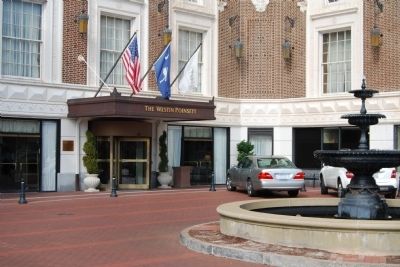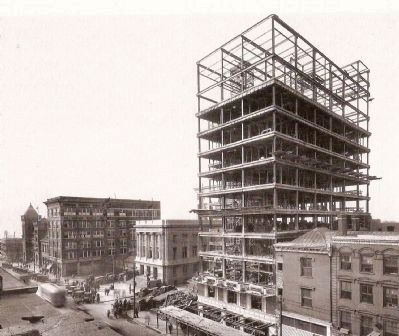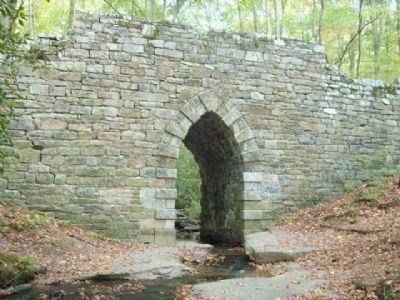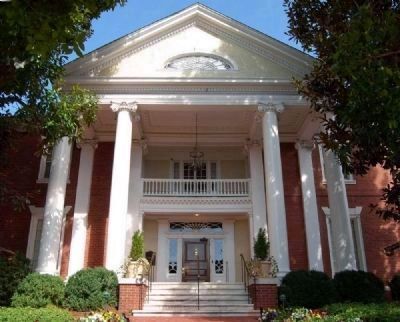Greenville in Greenville County, South Carolina — The American South (South Atlantic)
Joel Roberts Poinsett
1759 - 1851
Founder, National Institution for the Promotion of Science, forerunner of the Smithsonian Institution
• First United States Minister to Mexico •
• United States Secretary of War •
While serving as Minister to Mexico in 1825, Poinsett introduced to
America a species of the Euphorbia plant later named
Poinsettia pulcherrima in his honor.
Erected 2001.
Topics. This historical marker is listed in these topic lists: Horticulture & Forestry • Science & Medicine. A significant historical year for this entry is 1825.
Location. 34° 50.918′ N, 82° 24.004′ W. Marker is in Greenville, South Carolina, in Greenville County. Marker is on South Main Street. The marker is located between the Old Greenville County Courthouse and the Old Chamber of Commerce Building. Touch for map. Marker is at or near this postal address: 120 South Main Street, Greenville SC 29601, United States of America. Touch for directions.
Other nearby markers. At least 10 other markers are within walking distance of this marker. A different marker also named Joel Roberts Poinsett (within shouting distance of this marker); Vardry McBee (within shouting distance of this marker); The Old Record Building (within shouting distance of this marker); Poinsett's Spring (within shouting distance of this marker); Chamber of Commerce Building (within shouting distance of this marker); Spirit of Freedom (within shouting distance of this marker); City of Greenville 9-11 Plaque (within shouting distance of this marker); Greenville County Courthouse / The Willie Earle Lynching Trial (within shouting distance of this marker); Carolina Supply Company (about 300 feet away, measured in a direct line); South Carolina's First National Bank (about 300 feet away). Touch for a list and map of all markers in Greenville.
Regarding Joel Roberts Poinsett. Joel Poinsett's influence is found throughout Greenville County. Items and locations named for him include a bridge, club, hotel, highway, and charitable society.
Also see . . .
1. Joel Roberts Poinsett. Joel Roberts Poinsett (March 2, 1779 – December 12, 1851) was a physician, botanist and American statesman. (Submitted on January 11, 2009, by Brian Scott of Anderson, South Carolina.)
2. Find a Grave: Joel Roberts Poinsett. Birth: Mar. 2, 1779, Charleston, Charleston County, South Carolina. Death: Dec. 12, 1851, Stateburg Sumter County, South Carolina.
(Submitted on March 10, 2010, by Brian Scott of Anderson, South Carolina.)
3. Full text of The Life and Services of Joel R. Poinsett. Through the courtesy of the surviving member of Mr. Poinsett's family, the Historical Society has been placed in the possession of a mass of papers which illustrate very fully his public and his private life. (Submitted on March 10, 2010, by Brian Scott of Anderson, South Carolina.)
4. Poinsettia Day. “December 12th is Poinsettia Day. The date marks the death of Joel Roberts Poinsett, an American botanist, physician and Minister to Mexico who in 1828 sent cuttings of the plant he'd discovered in Southern Mexico to his home in Charlotte, South Carolina. Botanically, the plant is known as Euphorbia Pulcherrima.” (Submitted on March 11, 2010, by Brian Scott of Anderson, South Carolina.)
5. Euphorbia pulcherrima. Wikipedia entry for Euphorbia pulcherrima, commonly named poinsettia, is a species of flowering plant indigenous to Mexico and Guatemala. (Submitted on March 11, 2010, by Brian Scott of Anderson, South Carolina.)
6. Poinsett Hotel. The Poinsett Hotel was one of the first skyscrapers to be constructed in Greenville. (Submitted on March 11, 2010, by Brian Scott of Anderson, South Carolina.)
7. Poinsett Bridge. Poinsett Bridge, which is named for Joel Roberts Poinsett, was built in 1820 as part of a road from Columbia, South Carolina to Saluda Mountain. (Submitted on March 11, 2010, by Brian Scott of Anderson, South Carolina.)
Additional commentary.
1. Joel Roberts Poinsett (1779-1851)
Joel Roberts Poinsett, a Representative from South Carolina; born in Charleston, S.C., March 2, 1779; spent his early childhood in England; returned to America in 1788; attended private school at Greenfield Hill, Conn., and later in Wandsworth, near London, England; studied medicine at the University of Edinburgh, Scotland, and attended the military school in Woolwich, England; returned to Charleston, S.C., in 1800; studied law for a few months; traveled extensively in Europe from 1801 to 1809, returning to the United States for short intervals; sent to South America by President Madison in 1809 to investigate the prospects of the revolutionists there in their struggle for independence from Spain; returned to Charleston, S.C., in 1816; member of the state house of representatives 1816-1819; served as president of the board of public works; declined the offer of commissioner to South America by President Monroe; elected as a Republican to the Seventeenth Congress reelected as a Jackson Republican to the Eighteenth Congress, and elected as a Jacksonian to the Nineteenth Congress and served from March 4, 1821, to March 7, 1825, when he resigned to enter the diplomatic service; Minister to Mexico 1825-1829; member of the state house of representatives, 1830-1831; Secretary of War in the Cabinet of President Van Buren 1837-1841; died near what is now Statesburg, Sumter County, S.C., December 12, 1851; interment in the Church of the Holy Cross (Episcopal) Cemetery.
— Submitted March 10, 2010, by Brian Scott of Anderson, South Carolina.
2. About Joel Roberts Poinsett
It's widely known that Joel Poinsett was the first ambassador to Mexico, a position he held for five years, but he also served as the first consul-general of the United States to Buenos Aries, Argentina, and Santiago, Chile. He studied medicine and law, and not surprisingly was extremely well traveled, but he also had interests in natural history, science, and politics.
While serving in the South Carolina legislature, Poinsett was appointed president of the board of public works from 1819 to 1821, a position that had him overseeing construction of the state road that traversed Saluda Mountain. This road (modern-day S.C. Secondary Road 42) ran from Charleston, through Columbia, and into North Carolina, creating a seamless connector capable of accommodating even the "heaviest load," in places of several ineffective roads already in existence. Not surprisingly, more than twenty years later, he would join Vardry McBee and others to support connecting Columbia and Greenville by rail. (Source: G: The Magazine of Greenville, Jan/Feb 09, pg 68.)
— Submitted March 10, 2010, by Brian Scott of Anderson, South Carolina.
3. Joel Poinsett: History in Brief
At a Glance Poinsett was an eternal public servant and an amateur botanist. He served in both the South Carolina legislature and the U.S. Congress, was appointed secretary of war, and served as an ambassador to several countries.
Claim to Fame During his tenure as the first U.S. minister to Mexico from 1825-1830, Poinsett brought with him the Euphorbia pulchernima plant, now known as the poinsettia.
Did You Know? Poinsett was named secretary of war by President Martin Van Buren, and during that tenure he worked with other like-minded public servants to found the National Institute for the Promotion of Science, a precursor to the Smithsonian Institute.
A Grave Tale Poinsett was a summer resident of Greenville, and died en route from Charleston to Greenville in 1851 at the home of Dr. William Anderson in Statesburg,
South Carolina. He is buried in the churchyard of the Church of the Holy Cross there, where his tombstone reads, "A pure patriot, an honest man, and a good Christian." (Source: G: The Magazine of Greenville, Jan/Feb 09, pg 69.)
— Submitted March 10, 2010, by Brian Scott of Anderson, South Carolina.
4. Poinsettia Day
By an Act of Congress, December 12 was set aside as National Poinsettia Day. The date marks the death of Joel Roberts Poinsett, who is credited with introducing the native Mexican plant to the United States. The purpose of the day is to enjoy the beauty of this popular holiday plant.
— Submitted March 11, 2010, by Brian Scott of Anderson, South Carolina.
5. Joel Poinsett on the Future of U.S. Maritime Supremacy
"The future of the United States in maritime commerce is immense. we are surely called to become the first maritime power of the globe. This is the result partly of the produce of our soil. We have in this country a mass of raw goods that the whole world needs. We are the most natural carriers of it. Furthermore, our national genius calls us to become, like the English, the brokers of foreign nations. Look at what is happening already: there are hardly any but Americans to carry to Europe the products of America, and European products arrive in America on American ships. Our vessels fill the harbours of Le Havre and Liverpool, in our own we see hardly a French or English vessel.
"The American sailor possesses an activity and an economic bent, he has an understanding of his own interests, unique with him. There is not an English or a French vessel crossing the ocean in as little time as ours, none that stays as short a time in port.; in this fashion we make up and more than make up our handicaps. Furthermore, the American has a quality which, on sea as on land, makes him singularly apt to succeed and make money. He is very civilized, and he is thrown in a society which is just beginning and where the industries have not yet had the time to class themselves in a hard and fast way. It follows that with us every man knows a little of everything, has since childhood been habituated to doing a little of all. Our labourers make shows, their wives cloth and rugs. There is a phrase constantly in our mouths at the sight of an obstacle: and it's a phrase that portrays us perfectly: 'I will try.'" (Source: Tocqueville in America by George Wilson Pierson (1996) pgs 643-644.)
— Submitted March 11, 2010, by Brian Scott of Anderson, South Carolina.
6. Poinsett Hotel
Built in 1925 at a cost of $1.5 million, the Poinsett hotel was designed by W.L. Stoddard, a New York architect, and built by the J.E. Sirrine Company of Greenville. The Poinsett is a twelve-story skyscraper with a narrow rectangular plan and an L-shaped facade. The four-story base of the Poinsett is highlighted by tall arched windows that span the second and third stories. A wide cornice separates the base from the unornamented shaft. The shaft has seven stories. A wide cornice separates the base from the unornamented shaft. The shaft has seven stories, with three bays on the left side of the facade, four bays on the side of the projecting ell, and three bays on the projecting left side of the facade. The composition is capped by a capital story, which is separated from the intermediate shaft by a belt course. The capital story has brick diapering between the windows. A broad friese with terracotts festoons and urns between small transom windows is above these windows. A full cornice with dentils and modillion blocks surmounts the frieze. A balustrades parapet is above the cornice. The side and rear elevations of the Poinsett Hotel are less elaborate, with regular fenestration. The hotel features a ballroom, a convention hall, a male dining room, private dining rooms, a grill room, a lounge, eight to ten shops and stores, and
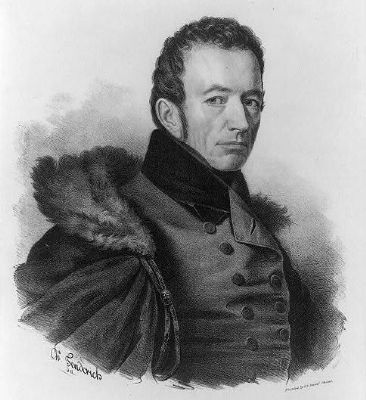
Charles Fenderich, Library of Congress
9. Joel Roberts Poinsett
(1779-1851)
(1779-1851)
S.C. House of Representatives 1816-1820
S.C. Board of Public Works 1818-1820
U.S. House of Representatives from South Carolina 1821-1825
Special U.S. Envoy to Mexico 1822-1823
U.S. Ambassador to Mexico 1825-1830
S.C. House of Representatives 1830-1833
U.S. Secretary of War 1837–1841
The Poinsett Hotel was one of the first skyscrapers to be constructed in Greenville. The hotel, named after Joel R. Poinsett, the Secretary of War under President Fillmore, was touted as "South Carolina's finest." It was built on the site of the Mansion House, an 1824 resort hotel. The Poinsett Hotel marks an era of Greenville’s building boom and growth in the 1920s. It has remained open as a hotel until recent years, when it was converted into apartments for the elderly. [Ed. Note: The hotel has since reopened.] The interior retains much of its original fabric, including decorative plaster work and marble. William L. Stoddard, the hotel's architect, was a distinguished New york architect who designed major hotels in many cities across the nation, including the Charleston, South Carolina hotel. The Poinsett Hotel exemplifies the early twentieth century mode of skyscraper construction and composition. (Source: National Registration nomination form.)
— Submitted March 11, 2010, by Brian Scott of Anderson, South Carolina.
7. The Poinsett Bridge
A massive stone bridge with pointed arches of rough wedge-shaped blocks under which runs Gap Creek, a mountain stream. Constructed without
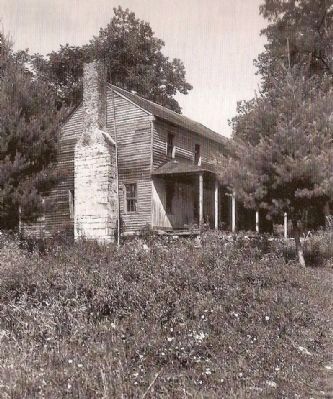
William B. Coxe Collection, Greenville County Historical Society
10. Summer Home of Joel and Mary Poinsett
The home shown is the second summer home of the Poinsetts. The first, known as Homestead, and was located on Pendleton Road, west of Greenville. Due to the endless steam of visitors, the Poinsetts moved to the northwestern section of Greenville County. The house shown is no longer standing. (Source: Remembering Greenville: Photographs from the Coxe Collection by Jeffrey R. Willis and the Greenville County Historical Society, 2006, pg 143.)
The Carolina Foothills Garden Club of Greenville, South Carolina, is restoring the bridge and immediately surrounding area. About one-half mile of the original roadbed has been cleared. – half of it for parking area adjacent to the bridge. Underbrush obscuring the bridge’s western face has been removed; road bed on bridge has been filled to approximately its former grade to protect arches from damaging water seepage. Poinsett Spring nearby has been cleared. Noted for its abundance of wildflowers, the area around the bridge is planned to be a Wildlife Park with nature trails and additional plantings to prevent erosion.
Significance
Constructed in 1820, the bridge is one of the oldest spans extant in South Carolina. Impressive construction of wedge-shaped rocks, erected without concrete, has pointed Gothic arches that are rate in the state today. Part of the State Road from Charleston through Columbia to North Carolina designed in 1817-1819 by Joel Poinsett, director of the South Carolina Board of Public Works. The bridge was named in his honor. Poinsett was also secretary of war, minister to Mexico, and first president of the National Institute for the Promotion of Science, forerunner of the Smithsonian Institute. Since
he was elected to Congress in 1820, the road (1829) and possibly the bridge were completed under the supervision of Abram Blanding, acting commissioner of the board. According to local legend, the bridge was built with the help of Indians living in the area.
Tulane University Library has a brush drawing by Robert Mills of a bridge with Gothic arches and a keystone identical to those of the Poinsett Bridge, which lends credence to the popular belief that Mills designed the bridge. In 1820 Mills became State Architect and Engineer for the South Carolina Board of Public Works. (Source: National Register nomination form.)
— Submitted March 11, 2010, by Brian Scott of Anderson, South Carolina.
8. The Poinsett Club, 807 E. Washington Street
1904, two-and-one-half-story brick building with gable roof. This Neoclassic style house was the former home of Lewis W. Parker, who consolidated fifteen cotton mills in Greenville into one corporation. Later it became the home of the Poinsett club, Greenville's oldest men's club. The main feature of the house is a monumental portico with a denticulated pediment supported by Ionic columns. The central doorway has a transom and sidelights flanked by pilasters and topped by a balcony with a balustrade. The house also features a modified Palladian window on the east elevation, quoins, and flat-arched lintels with keystones and terminal voussoirs. (Source: National Register nomination form for the Pettigru Historic District.)
— Submitted March 11, 2010, by Brian Scott of Anderson, South Carolina.
Credits. This page was last revised on November 16, 2020. It was originally submitted on June 1, 2008, by Brian Scott of Anderson, South Carolina. This page has been viewed 3,221 times since then and 30 times this year. Photos: 1, 2. submitted on June 1, 2008, by Brian Scott of Anderson, South Carolina. 3. submitted on January 11, 2009, by Brian Scott of Anderson, South Carolina. 4. submitted on May 26, 2008, by Brian Scott of Anderson, South Carolina. 5. submitted on March 10, 2010, by Brian Scott of Anderson, South Carolina. 6. submitted on June 1, 2008, by Brian Scott of Anderson, South Carolina. 7, 8. submitted on January 11, 2009, by Brian Scott of Anderson, South Carolina. 9. submitted on March 21, 2009, by Brian Scott of Anderson, South Carolina. 10. submitted on April 12, 2009, by Brian Scott of Anderson, South Carolina. 11. submitted on January 11, 2009, by Brian Scott of Anderson, South Carolina. 12. submitted on February 3, 2009, by Brian Scott of Anderson, South Carolina. 13. submitted on April 12, 2009, by Brian Scott of Anderson, South Carolina. 14. submitted on March 21, 2009, by Brian Scott of Anderson, South Carolina. 15. submitted on April 12, 2009, by Brian Scott of Anderson, South Carolina. • Kevin W. was the editor who published this page.
